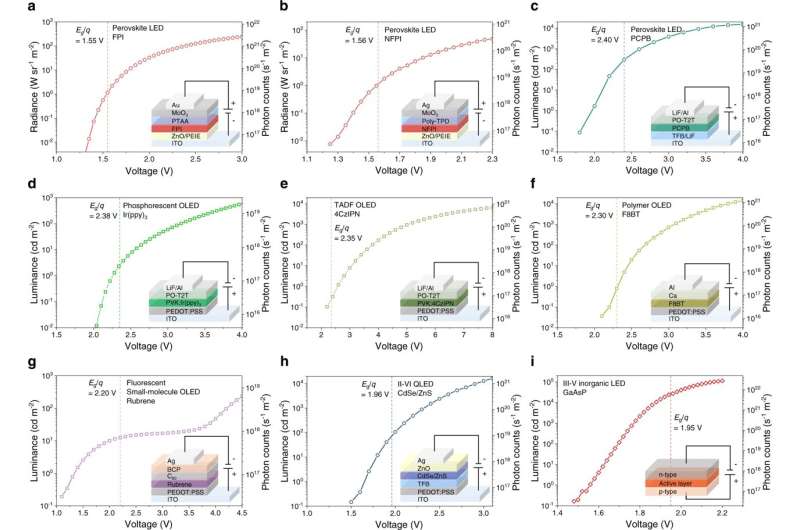Solving the mystery of ultralow-voltage LEDs

Light-emitting diodes (LEDs) have created far-reaching impacts on display and lighting industries. For a LED to emit light, the minimum voltage is widely considered to be equal to the bandgap voltage of the material, in consideration of the energy conservation principle. Reducing the operating voltages of LEDs can save power and improve speed.
In recent years, light emission at sub-bandgap voltages (typically 80-100% of the bandgaps) was observed for some emerging classes of LEDs, including organic LEDs (OLEDs), perovskite LEDs and quantum-dot LEDs. These observations were explained using material-specific mechanisms such as thermally-assisted upconversion and exciton-exciton annihilation, etc. These were proposed to offer small energy gains to overcome the "energy barrier" between the applied voltage and the bandgap. However, the fundamental questions of what the lowest possible voltages for LEDs really are, and whether they arise from the same physical origin, remain unanswered.
Recently, a research team led by Prof. Di Dawei at the College of Optical Science and Engineering of Zhejiang University discovered that light emission from LEDs can be observed at record-low voltages of 36–60% of the bandgaps. The results were collected, using a high-sensitivity photon detection system, from 17 types of LEDs based on perovskite, organic, quantum-dot and commercial III-V semiconductors. These voltages were too low to be explained by the previously reported mechanisms, and they revealed a universal origin of low-voltage LED operation. The research was carried out in collaboration with Prof. Sir Richard Friend at the Cavendish Laboratory of Cambridge University. A paper entitled "Ultralow-voltage operation of light-emitting diodes" was published by the researchers recently in Nature Communications.
"What is the minimum voltage for an LED to generate light has been a puzzle since its invention, and is a subject of ongoing debate," said Di, the corresponding author of the paper, "we look into this problem by comparing low-voltage electroluminescence from many classes of LEDs in a single study, and collected some exciting results which could help achieving a unified understanding."
Lian Yaxiao, a Ph.D. student in Di's group and the first author of the paper, says that "to find out how low the operating voltages can reach, we built a very sensitive measurement system capable of detecting much lower photon counts compared to conventional LED testers. It turns out that the minimum voltage can be as low as 36% of the bandgap. These are below the limits set by mechanisms reported in the past. Low-voltage operation is not limited to some special LEDs, it is a universal phenomenon across all 17 types of LEDs we tested."
Despite the drastically different modes of charge transport and recombination in these devices, the authors found that the low-voltage operation of these LEDs looks surprisingly similar. Prof. Lan Dongchen of the College of Electrical Engineering, Zhejiang University, co-first author of the paper, says that they "were able to construct a diode model to understand the LED emission behavior. It is interesting to note that the low-voltage characteristics of all the LEDs can be described using this model."
The authors reported that the minimum voltages measured were actually the apparent thresholds—the real threshold voltages may approach zero. Based on the diode model and the experimental results, the researchers found that the apparent threshold voltages of LEDs can be reduced in various ways, for examples, by improving the emission efficiency, reducing the series resistance, and by adjusting the bandgap and dark saturation currents of the LEDs.
Xing Shiyu, a Ph.D. student in Di's group and co-first author of the paper, says that "to understand the problem further we carried out device simulations using an LED simulation software. We found that the low-voltage characteristics of perovskite and organic LEDs are not very different from that of conventional LEDs based on III-V semiconductors. The temperature-dependent carrier distribution and emission properties can be described using Fermi-Dirac statistics."
The experiments and analyses of the study provide a unified answer to the long-standing puzzle of low-voltage LED operation. "The emission arises from the radiative recombination of non-thermal-equilibrium band-edge carriers whose populations are determined by the Fermi-Dirac function perturbed by a small voltage," said Di, "such process allows operating voltages to approach zero without violating the energy conservation principle."
Besides revealing the universal mechanism of ultralow-voltage LED operation, the research team demonstrated a prototypical communications setup capable of sending optical data to a silicon detector using a perovskite LED driven at voltages below the silicon's bandgap. These experiments demonstrates the potential of low-voltage LEDs for communications, logic and energy applications.
More information: Yaxiao Lian et al, Ultralow-voltage operation of light-emitting diodes, Nature Communications (2022). DOI: 10.1038/s41467-022-31478-y




















